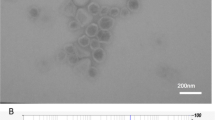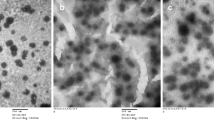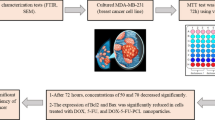Abstract
In this paper, we investigated the delivery efficiency of doxorubicin by magnetite nanoparticles with different shape to LNCaP and PC-3 prostate cancer cell lines. Cubic and spherical nanoparticles of magnetite were synthesized in organic medium and hydrophilized by non-ionic surfactant Pluronic F127—polyethylene-polypropylene oxide polymer. Doxorubicin was loaded into hydrophobic region of polymeric shell. We have observed that cytotoxicity and distribution of doxorubicin in cells changed significantly in case of drug loaded into nanoparticles in comparison with free doxorubicin. We have shown that this change is due to two main reasons: (1) slower internalization of nanoparticles by cells compared to free doxorubicin and (2) slow and incomplete release of doxorubicin from nanoparticle polymer shell. Interestingly, nanoparticle shape influenced cytotoxicity and the dynamics of drug accumulation inside cancer cells. We have found that doxorubicin-loaded cubic nanoparticles were more toxic for both cell lines compared to spherical ones. Moreover, doxorubicin from cubic nanoparticles accumulated in cells faster than the drug loaded in spherical nanoparticles. So, our work shows that for efficient drug delivery, not only size and coating should be taken into account but also the shape of initial core as it plays an important role in nanoparticle interaction with cells.
















Similar content being viewed by others
References
Ling, D., & Hyeon, T. (2013). Chemical design of biocompatible iron oxide nanoparticles for medical applications. Small, 9, 1450–1466. https://doi.org/10.1002/smll.201202111.
Majewski, P., & Thierry, B. (2007). Functionalized Magnetite Nanoparticles - Synthesis, Properties, and Bio-Applications. Critical Reviews in Solid State and Materials Sciences, 32, 203–215. https://doi.org/10.1080/10408430701776680.
Xie, J., Huang, J., Li, X., & Sun, S. (2009). X. C. Iron oxide nanoparticle platform for biomedical applications. Current Medicinal Chemistry, 16, 1278–1294. https://doi.org/10.2174/092986709787846604.
Oh, J. K., & Park, J. M. (2011). Iron oxide-based superparamagnetic polymeric nanomaterials: Design, preparation, and biomedical application. Progress in Polymer Science, 36, 168–189. https://doi.org/10.1016/j.progpolymsci.2010.08.005.
Laurent, S., Forge, D., Port, M., Roch, A., Robic, C., Vander Elst, L., et al. (2008). Magnetic iron oxide nanoparticles: Synthesis, stabilization, vectorization, physicochemical characterizations and biological applications. Chemical Reviews, 108, 2064–2110. https://doi.org/10.1021/cr068445e.
Srinivasan, S., Paknikar, K., Gajbhiye, V., & Bodas, D. (2017). Magneto-conducting Core/Shell Nanoparticles for Biomedical Applications. Chemistry of Nanomaterials, 3, 1–15. https://doi.org/10.1002/cnma.201700278.
Lin, J. J., Chen, J. S., Huang, S. J., Ko, J. H., Wang, Y. M., Chen, T. L., et al. (2009). Folic acid-Pluronic F127 magnetic nanoparticle clusters for combined targeting, diagnosis, and therapy applications. Biomaterials, 30, 5114–5124. https://doi.org/10.1016/j.biomaterials.2009.06.004.
Regmi, R., Bhattarai, S. R., Sudakar, C., Wani, A. S., Cunningham, R., Vaishnava, P. P., et al. (2010). Hyperthermia controlled rapid drug release from thermosensitive magnetic microgels. Journal of Materials Chemistry, 20, 6158–6163. https://doi.org/10.1039/C0jm00844c.
Regmi, R., Bhattarai, S. R., Sudakar, C., Wani, A. S., Cunningham, R., Vaishnava, P. P., et al. (2010). Hyperthermia controlled rapid drug release from thermosensitive magnetic microgels. Journal of Materials Chemistry, 20, 6158–6163. https://doi.org/10.1039/C0jm00844c.
Xu, Y., Zhu, Y., Kaskel, S., Wang, L., Shi, J., Zheng, Y., et al. (2015). A smart magnetic nanosystem with controllable drug release and hyperthermia for potential cancer therapy. RSC Advances, 5, 99875–99883. https://doi.org/10.1039/C5RA17053B.
Khandhar, A. P., Ferguson, R. M., & Krishnan, K. M. (2011). Monodispersed magnetite nanoparticles optimized for magnetic fluid hyperthermia: Implications in biological systems. Journal of Applied Physics, 109, 2011–2014. https://doi.org/10.1063/1.3556948.
Monnier, C. A., Burnand, D., Rothen-Rutishauser, B., Lattuada, M., & Petri-Fink, A. (2014). Magnetoliposomes: Opportunities and challenges. European Journal of Nanomedicine, 6, 201–215. https://doi.org/10.1515/ejnm-2014-0042.
Cheng, D., Li, X., Zhang, G., & Shi, H. (2014). Morphological effect of oscillating magnetic nanoparticles in killing tumor cells. Nanoscale Research Letters, 9, 1–8. https://doi.org/10.1186/1556-276X-9-195.
Andhariya, N., Chudasama, B., Mehta, R. V., & Upadhyay, R. V. (2011). Biodegradable thermoresponsive polymeric magnetic nanoparticles: A new drug delivery platform for doxorubicin. Journal of Nanoparticle Research, 13, 1677–1688. https://doi.org/10.1007/s11051-010-9921-6.
Tavano, L., Vivacqua, M., Carito, V., Muzzalupo, R., Caroleo, M. C., & Nicoletta, F. (2013). Doxorubicin loaded magneto-niosomes for targeted drug delivery. Colloids and Surfaces B Biointerfaces, 102, 803–807. https://doi.org/10.1016/j.colsurfb.2012.09.019.
Jain, T. K., Foy, S. P., Erokwu, B., Dimitrijevic, S., Flask, C. A., & Labhasetwar, V. (2009). Magnetic resonance imaging of multifunctional pluronic stabilized iron-oxide nanoparticles in tumor-bearing mice. Biomaterials, 30, 6748–6756. https://doi.org/10.1016/j.biomaterials.2009.08.042.
Fratila, R. M., Rivera-Fernández, S., & de la Fuente, J. M. (2015). Shape matters: synthesis and biomedical applications of high aspect ratio magnetic nanomaterials. Nanoscale, 7, 8233–8260. https://doi.org/10.1039/C5NR01100K.
Sajanlal, P. R., Sreeprasad, T. S., Samal, A. K., & Pradeep, T. (2011). Anisotropic nanomaterials: structure, growth, assembly, and functions. Nanotechnology Reviews, 2, 5883. https://doi.org/10.3402/nano.v2i0.5883.
Yang, H., Liu, C., Yang, D., Zhang, H., & Xi, Z. (2009). Comparative study of cytotoxicity, oxidative stress and genotoxicity induced by four typical nanomaterials: The role of particle size, shape and composition. Journal of Applied Toxicology, 29, 69–78. https://doi.org/10.1002/jat.1385.
Nair, S., Sasidharan, A., Divya Rani, V. V., Menon, D., Nair, S., Manzoor, K., et al. (2009). Role of size scale of ZnO nanoparticles and microparticles on toxicity toward bacteria and osteoblast cancer cells. Journal of Materials Science Materials in Medicine, 20, 235–241. https://doi.org/10.1007/s10856-008-3548-5.
Huang, X., Teng, X., Chen, D., Tang, F., & He, J. (2010). The effect of the shape of mesoporous silica nanoparticles on cellular uptake and cell function. Biomaterials, 31, 438–448. https://doi.org/10.1016/j.biomaterials.2009.09.060.
Xiong, Y., Brunson, M., Huh, J., Huang, A., Coster, A., Wendt, K., et al. (2013). The role of surface chemistry on the toxicity of Ag nanoparticles. Small, 9, 2628–2638. https://doi.org/10.1002/smll.201202476.
Tarantola, M., Pietuch, A., Schneider, D., Rother, J., Sunnick, E., Rosman, C., et al. (2011). Toxicity of gold-nanoparticles: Synergistic effects of shape and surface functionalization on micromotility of epithelial cells. Nanotoxicology, 5, 254–268. https://doi.org/10.3109/17435390.2010.528847.
Tacar, O., Sriamornsak, P., & Dass, C. R. (2013). Doxorubicin: An update on anticancer molecular action, toxicity and novel drug delivery systems. Journal of Pharmacy and Pharmacology, 65, 157–170. https://doi.org/10.1111/j.2042-7158.2012.01567.x.
Coelho, A. R., Martins, T. R., Couto, R., Deus, C., Pereira, C. V., Simões, R. F., et al. (1863). Berberine-induced cardioprotection and Sirt3 modulation in doxorubicin-treated H9c2 cardiomyoblasts. Biochimica et Biophysica Acta - Molecular Basis Disease, 2017, 2904–2923. https://doi.org/10.1016/j.bbadis.2017.07.030.
Wang, J., Gong, C., Wang, Y., & Wu, G. (2014). Magnetic and pH sensitive drug delivery system through NCA chemistry for tumor targeting. RSC Advances, 4, 15856–15862. https://doi.org/10.1039/C4RA00660G.
Gautier, J., Munnier, E., Paillard, A., Hervé, K., Douziech-Eyrolles, L., Soucé, M., et al. (2012). A pharmaceutical study of doxorubicin-loaded PEGylated nanoparticles for magnetic drug targeting. International Journal of Pharmaceutics, 423, 16–25. https://doi.org/10.1016/j.ijpharm.2011.06.010.
Guo, X., Shi, C., Yang, G., Wang, J., Cai, Z., & Zhou, S. (2014). Dual-Responsive Polymer Micelles for Target-Cell-Speci fi c Anticancer Drug Delivery. Chemistry of Materials, 26, 4405–4418. https://doi.org/10.1021/cm5012718.
Yu, W. W., Falkner, J. C., Yavuz, C. T., & Colvin, V. L. (2004). Synthesis of monodisperse iron oxide nanocrystals by thermal decomposition of iron carboxylate salts. Chemical Communications, 2306–2307. https://doi.org/10.1039/b409601k.
Park, J., An, K., Hwang, Y., Park, J.-G., Noh, H.-J., Kim, J.-Y., et al. (2004). Ultra-large-scale syntheses of monodisperse nanocrystals. Nature Materials, 3, 891–895. https://doi.org/10.1038/nmat1251.
Hai, H. T., Yang, H. T., Kura, H., Hasegawa, D., Ogata, Y., Takahashi, M., et al. (2010). Size control and characterization of wustite (core)/spinel (shell) nanocubes obtained by decomposition of iron oleate complex. Journal of Colloid and Interface Science, 346, 37–42. https://doi.org/10.1016/j.jcis.2010.02.025.
Simon, T., Boca, S., Biro, D., Baldeck, P., & Astilean, S. (2013). Gold-Pluronic core-shell nanoparticles: Synthesis, characterization and biological evaluation. Journal of Nanoparticle Research, 15(1578), 1–8. https://doi.org/10.1007/s11051-013-1578-5.
Gonzales, M., & Krishnan, K. M. (2007). Phase transfer of highly monodisperse iron oxide nanocrystals with Pluronic F127 for biomedical applications. Journal of Magnetism and Magnetic Materials, 311, 59–62. https://doi.org/10.1016/j.jmmm.2006.10.1150.
Kireev, I., Lakonishok, M., Liu, W., Joshi, V. N., Powell, R., & Belmont, A. S. (2008). In vivo immunogold labeling confirms large-scale chromatin folding motifs. Nature Methods, 5, 311–313. https://doi.org/10.1038/nmeth.1196.
Zhou, Z., Zhu, X., Wu, D., Chen, Q., Huang, D., Sun, C., et al. (2015). Anisotropic shaped iron oxide nanostructures: Controlled synthesis and proton relaxation shortening effects. Chemistry of Materials, 27, 3505–3515. https://doi.org/10.1021/acs.chemmater.5b00944.
Speelmans, G., Staffhorst, R. W. H. M., Steenbergen, H. G., & De Kruijff, B. (1996). Transport of the anti-cancer drug doxorubicin across cytoplasmic membranes and membranes composed of phospholipids derived from Escherichia coli occurs via a similar mechanism. Biochimica et Biophysica Acta - Biomembranes, 1284, 240–246. https://doi.org/10.1016/S0005-2736(96)00137-X.
Nitiss, J. L. (2009). Targeting DNA topoisomerase II in cancer chemotherapy. Nature Reviews Cancer, 9, 338–350. https://doi.org/10.1038/nrc2607.
Blatt, N. L., Mingaleeva, R. N., Khaiboullina, S. F., Lombardi, V. C., & Rizvanov, A. A. (2013). Application of cell and tissue culture systems for anticancer drug screening. World Applied Science Journal, 23, 315–325. https://doi.org/10.5829/idosi.wasj.2013.23.03.13064.
Halamoda Kenzaoui, B., Chapuis Bernasconi, C., Guney-Ayra, S., & Juillerat-Jeanneret, L. (2012). Induction of oxidative stress, lysosome activation and autophagy by nanoparticles in human brain-derived endothelial cells. The Biochemical Journal, 441, 813–821. https://doi.org/10.1042/BJ20111252.
Alieva, I. B., Kireev, I., Garanina, A. S., Alyabyeva, N., Ruyter, A., Strelkova, O. S., et al. (2016). Magnetocontrollability of Fe7C3@C superparamagnetic nanoparticles in living cells. Journal of Nanobiotechnology, 14, 67. https://doi.org/10.1186/s12951-016-0219-4.
Acknowledgements
The authors thank the Program of Moscow State University Development (PNR 5.13) for assistance in the study of nanoparticle intracellular localization by JEM-1400 (JEOL) transmission electron microscope.
Funding
The work was supported by the Ministry of Education and Science of the Russian Federation (grant no. 14.578.21.0201 (RFMEFI57816X0201)).
Author information
Authors and Affiliations
Contributions
A.G.M. conceived the research and guided the project. T.R.N. synthesized, modified, and characterized nanoparticles. G.I.S. carried out XRD and magnetic measurements. A.S.G. conducted the biological experiments. O.A.Z. prepared ultrathin sections for transmission electron microscopy analysis. T.R.N., A.S.G., M.A.A., A.G.S., and A.G.M. discussed the results. T.R.N. and A.S.G. wrote the manuscript. O.S.S., M.A.A., I.B.A., I.I.K., A.G.M., and A.G.S. critically revised the manuscript. All authors approved the final version of the manuscript.
Corresponding author
Ethics declarations
Competing Interests
The authors declare that they have no competing interests.
Rights and permissions
About this article
Cite this article
Nizamov, T.R., Garanina, A.S., Grebennikov, I.S. et al. Effect of Iron Oxide Nanoparticle Shape on Doxorubicin Drug Delivery Toward LNCaP and PC-3 Cell Lines. BioNanoSci. 8, 394–406 (2018). https://doi.org/10.1007/s12668-018-0502-y
Published:
Issue Date:
DOI: https://doi.org/10.1007/s12668-018-0502-y




